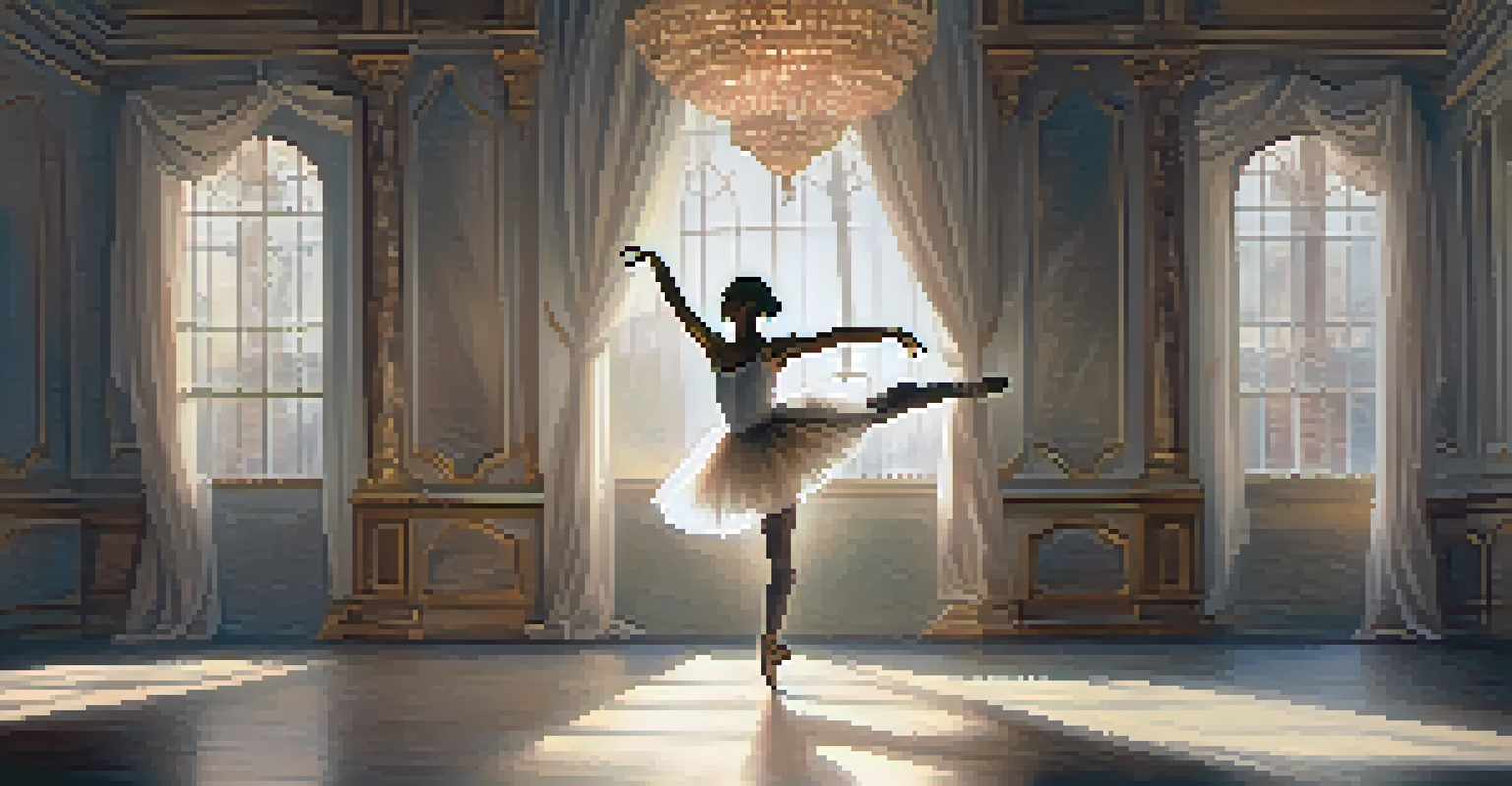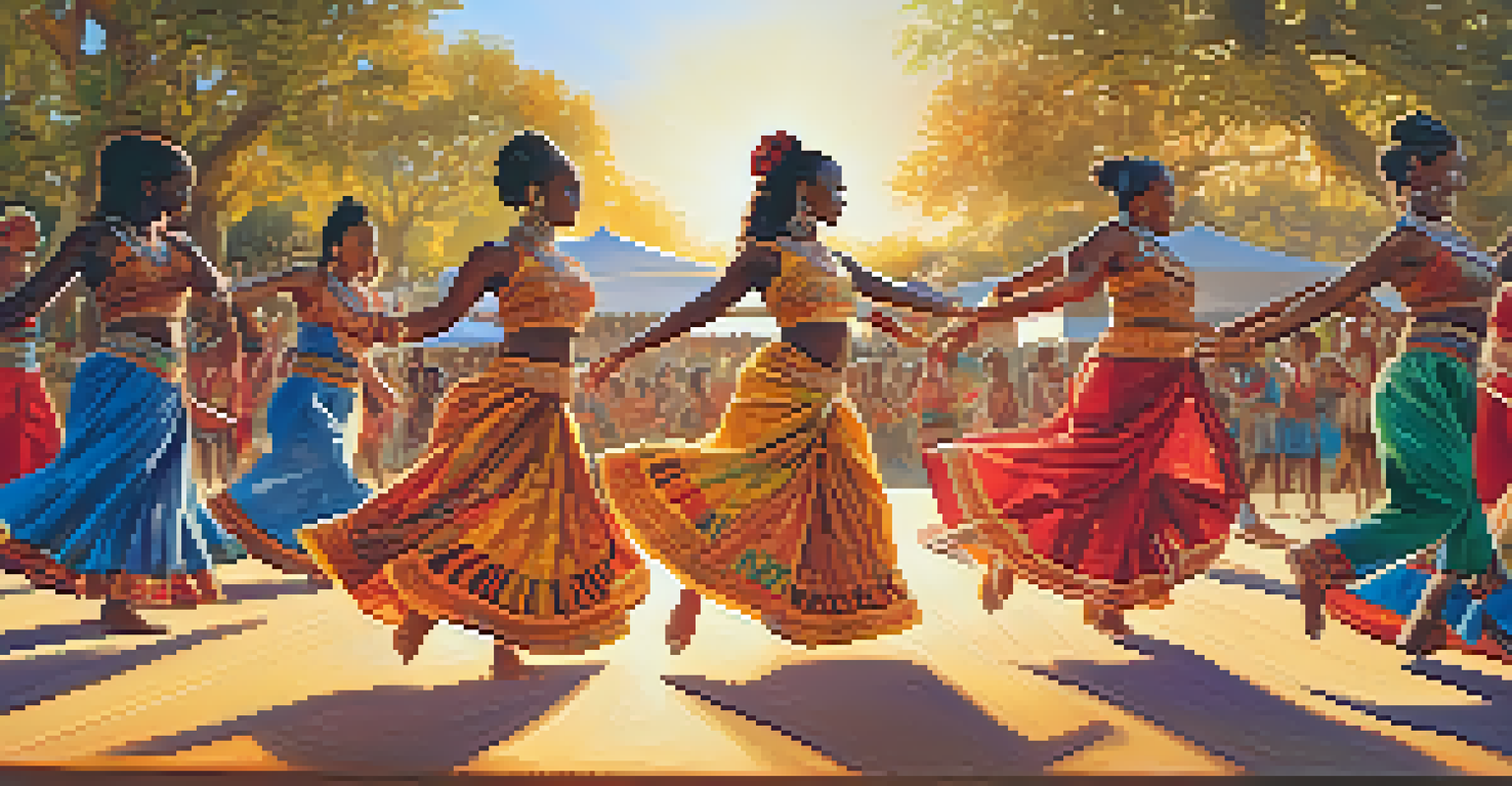Dance as a Storytelling Medium for Cultural Heritage

Understanding Dance as a Cultural Narrative
Dance has long been recognized as a vibrant form of expression, transcending mere entertainment. At its core, dance tells stories that reflect the values, beliefs, and history of a community. Just as written tales pass down wisdom, the movements and rhythms of dance communicate the essence of cultural heritage.
Dance is the hidden language of the soul.
For example, traditional dances often incorporate specific gestures that symbolize historical events or mythological tales. This creates a living narrative that engages audiences, allowing them to connect with their own cultural roots. Dance becomes a medium through which stories are not just told but experienced.
Moreover, the beauty of dance as storytelling lies in its ability to evolve yet remain rooted in tradition. As new generations reinterpret these movements, they breathe fresh life into age-old stories, ensuring that cultural narratives continue to resonate with contemporary audiences.
The Role of Dance in Preserving Cultural Heritage
Cultural heritage is like a tapestry woven from various threads, and dance is one of the most colorful strands. It serves as a tool for preservation, ensuring that traditions are not lost to time. Through performances, communities can pass down their unique stories, rituals, and values to future generations.

For instance, indigenous tribes often perform traditional dances during ceremonies, which not only celebrate their history but also educate younger members about their ancestry. This oral tradition, combined with movement, solidifies cultural identity and fosters a sense of belonging within the community.
Dance as Cultural Storytelling
Dance serves as a vibrant medium for expressing and preserving cultural narratives, reflecting the values and history of communities.
In many cases, when cultural practices are threatened by globalization, dance acts as a beacon of resilience. As communities come together to perform their dances, they reaffirm their heritage, showcasing their uniqueness in a world that can sometimes feel homogenized.
Dance as a Reflection of Societal Changes
Dance does not exist in a vacuum; it mirrors the societal changes and challenges of its time. For instance, during periods of social upheaval or change, dance can become a powerful vehicle for commentary and expression. This adaptability allows dance to stay relevant, communicating the struggles and triumphs of the community.
The dance is a poem of which each movement is a word.
Take, for example, the Harlem Renaissance, where dance styles like the Charleston reflected the shift in African American culture and identity. This evolution in dance not only entertained but also conveyed messages of freedom and empowerment, highlighting the community's resilience.
As cultures evolve, dance continues to be a dynamic narrative form, adapting to contemporary themes while retaining its traditional roots. This duality makes it an invaluable medium for storytelling that resonates across generations.
Case Study: Ballet and Its Cultural Narratives
Ballet, often seen as a high art form, carries with it a wealth of cultural narratives interwoven into its performances. From classic tales like 'Swan Lake' to contemporary pieces, ballet showcases themes of love, loss, and transformation that are universally relatable. The grace and precision of ballet movements serve to enhance these narratives, making them even more impactful.
Moreover, ballet has evolved to incorporate diverse cultural stories, reflecting a broader spectrum of human experience. This shift has allowed ballet to reach new audiences, fostering a more inclusive environment that honors various cultural narratives.
Emotional Connection Through Dance
The physicality of dance allows for a direct emotional impact, creating a visceral bond between performers and audiences.
By reimagining traditional ballets to include elements from different cultures, dancers and choreographers are expanding the storytelling potential of this art form. This not only enriches the ballet repertoire but also highlights the interconnectedness of human experiences across different cultures.
Global Dance Forms as Cultural Storytellers
Around the world, various dance forms serve as powerful storytellers, each with its unique flair and cultural significance. From the passionate flamenco of Spain to the intricate Bharatanatyam of India, these dances offer windows into the societies they represent. Each movement, rhythm, and costume choice carries deep cultural meanings and historical significance.
For instance, the Hula dance of Hawaii is not just a performance but a form of storytelling that conveys the history and mythology of the islands. The movements mimic natural elements and tell tales of gods, nature, and community, embodying the spirit of Hawaiian culture.
As globalization connects us more than ever, the sharing of these dance forms fosters appreciation and understanding across cultures. Learning about and engaging with different dance traditions enriches our collective narrative, making the world a more vibrant tapestry of stories.
The Emotional Impact of Dance as Storytelling
One of the most compelling aspects of dance as a storytelling medium is its emotional impact. Unlike other storytelling forms, dance taps directly into human emotions through physical movement, allowing audiences to feel the narrative on a visceral level. This connection can evoke powerful responses, often resonating long after the performance has ended.
For example, a simple gesture or expression during a dance can convey deep sorrow or joy, creating an immediate bond between performer and audience. The physicality of dance often transcends language barriers, making it a universal form of communication.
Dance Education Preserves Heritage
Through dance education, cultural narratives are transmitted to future generations, fostering appreciation and understanding of heritage.
This emotional resonance is what makes dance such a potent storytelling medium; it invites viewers to not only observe but to feel and reflect on the narrative being presented. Through dance, stories become lived experiences that foster empathy and understanding among diverse audiences.
Dance Education as a Means of Cultural Transmission
Education plays a pivotal role in preserving dance as a storytelling medium. Through dance education, cultural narratives are passed down, ensuring that the next generation understands and appreciates their heritage. Classes, workshops, and community performances serve as platforms for learning and sharing these rich narratives.
For example, many cultural organizations offer dance programs that teach traditional dances while also explaining the stories behind them. This not only preserves the dance form but also enriches students’ understanding of their cultural identity.

As students engage with dance, they not only learn about movement but also the historical context and significance behind each step. This holistic approach fosters a deeper appreciation for cultural heritage, encouraging individuals to become stewards of their own stories.